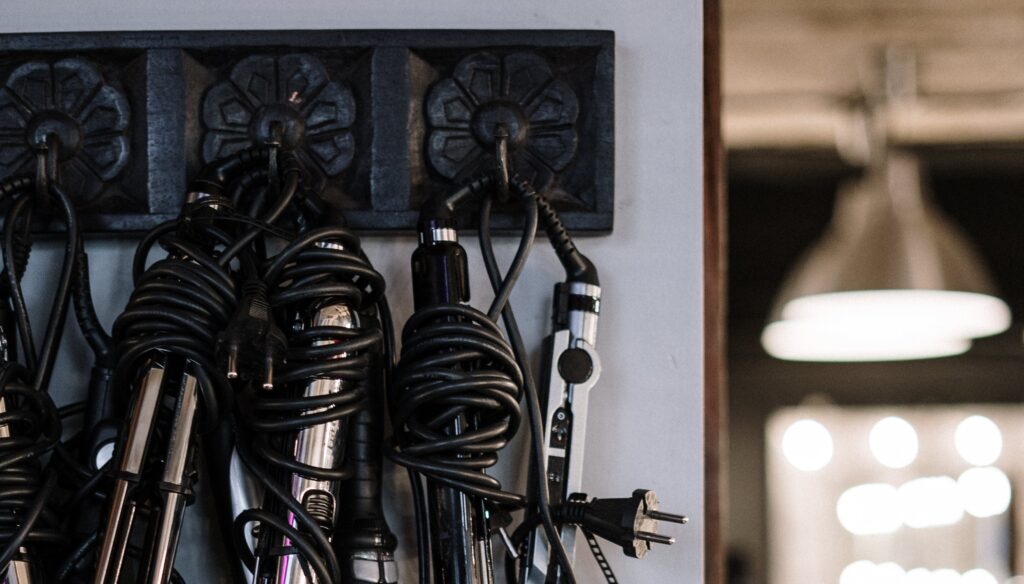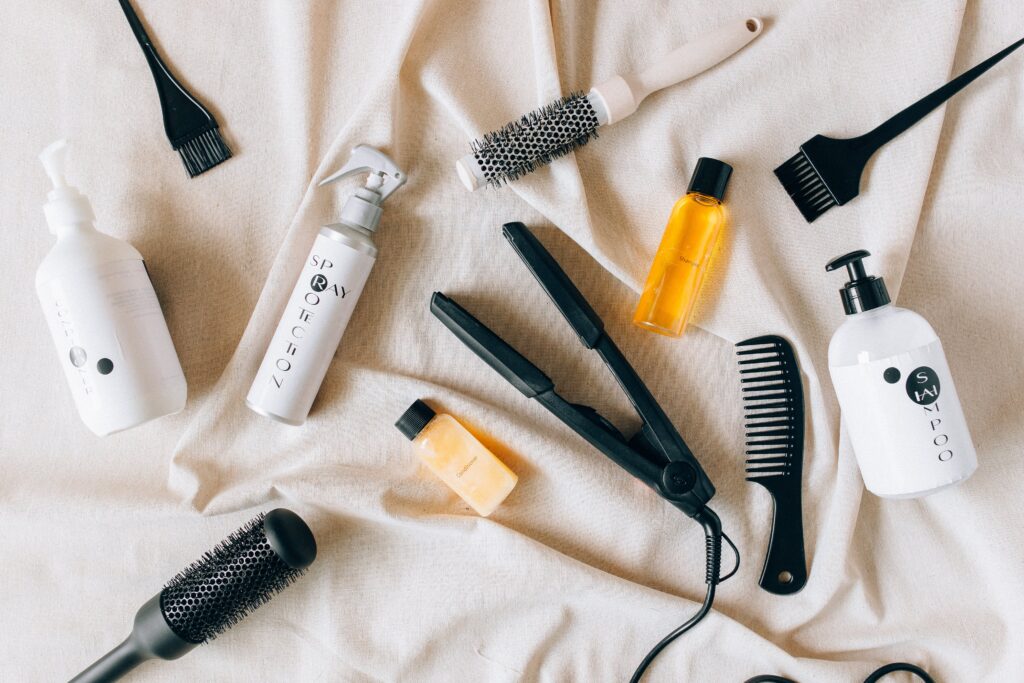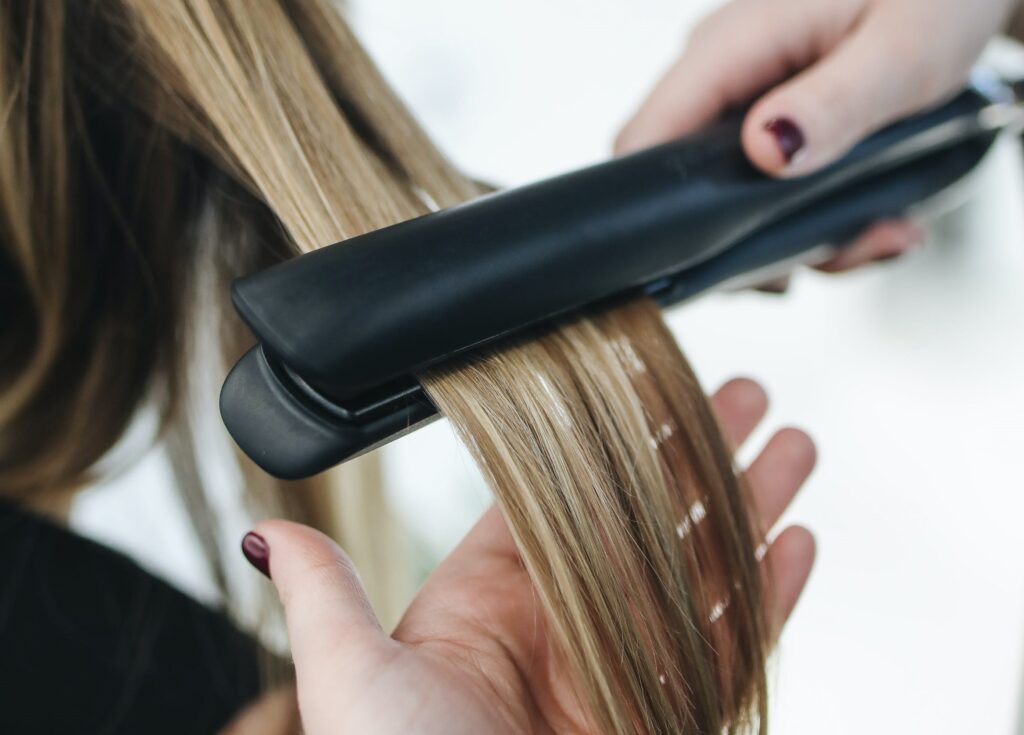Are you tired of spending hours straightening your hair, only for it to go limp and greasy the next day? Enter dry shampoo, the time-saving and convenient solution to fresh, voluminous hair. But, what about straightened hair? Will dry shampoo have the same revitalizing effects without undoing all your hard work? DOES dry shampoo ruin straightened hair?
In this article, we delve into the delicate balance between dry shampoo and straightened hair. Discover the effects of using dry shampoo on straightened hair and how it can help maintain your beautifully styled locks. We’ll explore the science behind dry shampoo, how it works on straightened hair, and whether it’s suitable for your specific hair type.
Uncover the dos and don’ts of using dry shampoo on straightened hair to ensure you achieve the best results. Whether you’re a time-strapped professional, a busy mom, or simply someone looking for an easy haircare routine, this article will provide the insights you need to make informed decisions about your haircare regimen.
How does dry shampoo work?
Dry shampoo is a quick-fix hair care product that works by absorbing excess oil and grease from your scalp and hair. Unlike traditional liquid shampoos that require water for activation, dry shampoo is applied directly to dry hair. Here’s how it works:
Oil Absorption: The main ingredient in dry shampoo is usually a fine powder, such as starch or clay, that has excellent oil-absorbing properties. When applied to the roots of your hair, it acts like a magnet, attracting and absorbing the oils that make your hair look greasy.
Application: To use dry shampoo, simply spray or sprinkle the product onto the roots of your dry hair, focusing on the areas that tend to get oily. The powder works its way through the strands, attaching to the excess oil.
Massaging and Brushing: After applying the dry shampoo, gently massage your scalp with your fingertips. This helps distribute the product and ensures even oil absorption. You can also use a brush or comb to work the product through your hair, removing any visible residue.
Volume and Texture: In addition to banishing oil, dry shampoo adds volume and texture to your hair. As it absorbs oil, it creates separation between the strands, making your hair look and feel fresher. This can be especially useful for adding life to limp or second-day hair.
Time-Saving: One of the key benefits of dry shampoo is its time-saving aspect. It’s a convenient solution for refreshing your hair between regular washes, extending the time between wash days without compromising on cleanliness or style.
Ingredients:
The key ingredients in dry shampoo include:
- Starch or Clay: Absorbs excess oil and grease.
- Alcohol or Silica: Enhances the product’s ability to evaporate and leave no residue.
- Fragrance: Provides a fresh scent to the hair.
- Propellants: Aerosol products may contain propellants for easy application.
- Conditioning Agents: Some formulations include ingredients to add softness or prevent excessive drying.
It’s important to note that while dry shampoo is a handy tool, it’s not a complete replacement for regular washing. Using it too frequently without washing your hair can lead to product build-up, potentially causing scalp issues.
The Pros and Cons of using dry shampoo on straightened hair
Pros:
Oil Absorption: Dry shampoo is effective at absorbing excess oil and grease, helping to keep straightened hair looking fresh and clean between washes.
Volume and Texture: Straightened hair can sometimes lack volume. Dry shampoo adds texture and lift, giving the hair a fuller and more voluminous appearance.
Prolongs Straightening: Washing your hair too frequently can strip away natural oils and compromise the longevity of your straightened style. Dry shampoo allows you to extend the time between washes, preserving the straightened look.
Time-Saving: Applying dry shampoo is a quick and convenient way to refresh your hair, especially on busy days when you don’t have time for a full wash and styling routine.
Cons:
Residue Build-up: Using dry shampoo too frequently can lead to product build-up, leaving a residue on the hair and scalp. This build-up can affect the appearance and health of straightened hair.
Potential for Dryness: Some dry shampoos may contain ingredients that can be drying to the hair and scalp. It’s essential to choose a product that suits your hair type and doesn’t cause excessive dryness.
Scalp Issues: If not applied and removed properly, dry shampoo can contribute to scalp issues such as itching or flakiness. It’s crucial to massage the product thoroughly and brush out any residue.
Masking Issues: While dry shampoo can absorb oil, it doesn’t address cleanliness. It’s not a substitute for washing your hair when it’s genuinely dirty, as it merely provides a temporary solution.
Here’s a simple table summarizing the pros and cons of using dry shampoo on straightened hair:
| Pros of Dry Shampoo on Straightened Hair | Cons of Dry Shampoo on Straightened Hair |
|---|---|
| 1. Absorbs excess oil and grease | 1. Risk of residue build-up |
| 2. Adds texture and volume | 2. Potential for dryness |
| 3. Prolongs the straightened style | 3. Possible scalp issues |
| 4. Time-saving option | 4. Not a substitute for regular washing |
Remember, the effectiveness of dry shampoo can vary based on the product and individual hair types, so it’s essential to choose wisely and use it in moderation.
Does Dry Shampoo Ruin Straightened Hair?
Here comes the main question: does dry shampoo ruin straightened hair. Well, the impact of dry shampoo on straightened hair hinges on its proper usage. When applied judiciously, dry shampoo typically doesn’t ruin straightened hair. However, overuse or incorrect application may lead to potential issues.
Residue build-up is a common concern associated with frequent dry shampoo application. Using it without subsequent proper cleansing can result in residue accumulation, potentially affecting the sleek appearance and shine of straightened hair.
Some dry shampoos contain ingredients that can contribute to dryness. If your straightened hair is already prone to dryness, using a dry shampoo with drying components may increase the risk of frizz or breakage.
Improper application and inadequate removal of dry shampoo can lead to scalp issues, such as itching or flakiness. Individuals with sensitive scalps may be particularly susceptible to these problems.
To maintain healthy straightened hair while using dry shampoo, it’s essential to choose a product suitable for your hair type, apply it in moderation, and ensure regular cleansing to prevent residue build-up.
Additionally, balancing dry shampoo use with moisturizing products can help address potential dryness concerns. Ultimately, responsible and mindful use is key to leveraging the benefits of dry shampoo without compromising the integrity of straightened hair.

Tips for using dry shampoo on straightened hair
Effectively using dry shampoo on straightened hair involves a thoughtful approach to enhance its benefits while mitigating potential drawbacks.
Use it Sparingly: Don’t go overboard with dry shampoo. Applying just enough prevents residue build-up and keeps your straightened hair looking smooth.
Section Your Hair: Additionally, divide your hair into sections before applying. This ensures you cover all areas evenly for a refreshed look.
Pick the Right Product: Choose a dry shampoo made for your hair type. Look for ones without harsh chemicals for a gentle touch.
Focus on the Roots: Apply dry shampoo mainly to your roots where oil gathers. Additionally, spray evenly from a distance for better coverage.
Massage and Comb Through: After applying, massage the dry shampoo into your scalp and comb it through. This helps distribute the product evenly.
Watch Product Layering: Avoid using too many products at once. Additionally, layering can lead to build-up and affect your straightened hair’s appearance.
Stretch Out Washes: Use dry shampoo to space out your washes. This helps maintain your straightened style for a more extended period.
Fight Dryness with Moisture: If your straightened hair tends to be dry, balance dry shampoo use with moisturizing products like conditioner or masks.
Stick to a Routine: Regularly wash your hair. Dry shampoo is handy, but it’s not a replacement for a thorough cleansing routine.
Experiment with Brands: Lastly, try different dry shampoo brands to find the one that suits your hair best. Scent, texture, and formula can vary, so find what works for you.
By following these tips, you can optimize the use of dry shampoo on straightened hair, keeping it refreshed and stylish while maintaining overall hair health.
The best dry shampoos for straightened hair
Here are some recommendations for dry shampoos that work well with straightened hair:
- Moroccanoil Dry Shampoo for Dark Tones:
- Ideal for darker hair tones.
- Refreshes and absorbs oil while maintaining rich hues.
- Living Proof Perfect Hair Day Dry Shampoo:
- Known for its effectiveness in oil absorption.
- Provides a clean, fresh scent for extended style life.
- Batiste Dry Shampoo:
- Budget-friendly option without compromising quality.
- Offered in a diverse array of fragrances and formulations to cater to individual tastes and preferences.
- Klorane Dry Shampoo with Oat Milk:
- Gentle formulation with oat milk.
- Absorbs oil without causing dryness, suitable for straightened hair.
- Bumble and Bumble Pret-a-Powder:
- Versatile option that adds volume and texture.
- Excellent for refreshing straightened hair while enhancing body.
Lastly, the key is not just in the brand but in choosing a product that aligns with your hair’s needs. Consider sulfate-free options, think about color preservation if applicable, and be mindful of how the product interacts with your hair type. Trial and error can often lead to finding the perfect fit for your straightened hair.
How to properly apply dry shampoo on straightened hair
Now we know the answer to “Does dry shampoo ruin straightened hair”, let’s also discover the proper way to apply. Properly applying dry shampoo to straightened hair is essential for achieving the desired results without compromising your sleek style. Here’s a step-by-step guide:
1. Section Your Hair: Before applying dry shampoo, section your straightened hair. This ensures even distribution of the product and effective oil absorption.
2. Choose the Right Dry Shampoo: Select a dry shampoo specifically formulated for straightened hair. Look for sulfate-free options to maintain the integrity of your straightening treatment.
3. Hold the Product at a Distance: Hold the dry shampoo spray or powder at a distance from your scalp. This helps prevent over-application and ensures an even distribution.
4. Focus on the Roots: Direct the dry shampoo mainly to the roots of your hair, where oil tends to accumulate. This is crucial for refreshing your hair without affecting the straightened texture.
5. Spray Evenly: If using a spray, apply it evenly across the parted sections of your hair. Ensure that you cover the entire root area for consistent oil absorption.
6. Massage into the Scalp: After applying the dry shampoo, gently massage it into your scalp using your fingertips. This helps distribute the product and ensures thorough absorption.
7. Comb Through: Use a wide-toothed comb or brush to comb through your hair. This not only aids in distributing the dry shampoo but also prevents any visible residue.
8. Check for Residue: Examine your hair to ensure there’s no visible residue. If you notice any, continue combing through or use your fingertips to blend the product into your hair.
By following these steps, you can properly apply dry shampoo to your straightened hair, refreshing its appearance without compromising the sleekness of your style.
Common myths about dry shampoo
Myth 1: Dry Shampoo Cleans Hair Like Regular Shampoo:
- Reality: Dry shampoo doesn’t clean hair; it absorbs oil. While it refreshes and adds volume, it doesn’t provide the same cleansing effect as regular shampoo.
Myth 2: Dry Shampoo Causes Hair Loss:
- Reality: When used correctly, dry shampoo doesn’t cause hair loss. However, excessive use or improper application can lead to product build-up, potentially impacting hair health.
Myth 3: Dry Shampoo is Suitable for Daily Use:
- Reality: Using dry shampoo daily isn’t recommended. Overuse can lead to product build-up, scalp issues, and may compromise the cleanliness of your hair.
Myth 4: Dry Shampoo is a Permanent Substitute for Washing:
- Reality: Dry shampoo is a temporary solution. It shouldn’t replace regular hair washing, as it doesn’t remove dirt, sweat, and environmental pollutants.
Myth 5: Dry Shampoo Damages Hair:
- Reality: When used properly, dry shampoo doesn’t damage hair. However, certain formulations may contain drying ingredients, so it’s crucial to choose the right product for your hair type.
Myth 6: Dark Hair Can’t Use Dry Shampoo:
- Reality: Many dry shampoos come in formulations suitable for dark hair. Look for options designed to avoid the white residue that can be visible on darker hair.
Myth 7: Dry Shampoo Causes Dandruff:
- Reality: Dry shampoo itself doesn’t cause dandruff. However, improper application, inadequate removal, or using it on a dirty scalp can contribute to scalp issues.
Myth 8: Dry Shampoo Only Adds Volume:
- Reality: While dry shampoo does add volume, its primary function is oil absorption. It refreshes hair between washes and can be a versatile styling tool.
By dispelling these common myths, you can better understand the proper use and benefits of dry shampoo in your hair care routine.
Alternatives to dry shampoo for straightened hair
If you’re seeking alternatives to dry shampoo for maintaining straightened hair, here are five options to consider:
1. Powdered Cornstarch or Arrowroot:
- How to Use: Apply a small amount of powdered cornstarch or arrowroot to the roots. Additionally, use a makeup brush or your fingertips to gently massage it into the scalp. This natural powder helps absorb excess oil and refreshes the hair.
2. DIY Rice Flour and Baking Soda Mix:
- How to Use: Create a homemade alternative by mixing equal parts rice flour and baking soda. Additionally, apply this mixture sparingly to the roots, focusing on areas with oil build-up. Massage it into the scalp, and then comb through your hair to distribute the powder.
3. Baby Powder:
- How to Use: Baby powder is a classic alternative to dry shampoo. Additionally, sprinkle a small amount onto the roots, allowing it to sit for a few minutes. Afterward, use a comb or brush to distribute the powder and remove any excess. It leaves your hair feeling refreshed and adds a subtle scent.
4. Waterless Foam Shampoo:
- How to Use: Waterless foam shampoos are designed for a no-rinse cleanse. Additionally, apply a small amount directly to the roots, massaging it in with your fingertips. Use a clean towel to blot away any excess foam. This option is convenient for on-the-go freshness.
5. Apple Cider Vinegar Rinse:
- How to Use: Mix one part apple cider vinegar with one part water in a spray bottle. Additionally, section your hair and spritz the mixture onto the roots. Allow it to air dry without rinsing. Apple cider vinegar helps remove excess oil and residue while balancing the scalp’s pH.
Note: While these alternatives can effectively absorb excess oil and refresh your hair, it’s essential to use them sparingly. Additionally, excessive use may lead to product build-up, affecting the overall health of your hair. Maintain a regular hair washing routine to ensure thorough cleansing and prevent any potential issues. Choose alternatives based on your hair type and personal preferences for the best results.

Frequently Asked Questions
1. Can I use dry shampoo after straightening my hair?
Answer: Yes, you can use dry shampoo after straightening your hair. It helps refresh your style and absorb excess oil without affecting the straightened texture.
2. Is dry shampoo good for straight hair?
Answer: Absolutely. Dry shampoo is versatile and benefits straight hair by absorbing oil, adding volume, and extending the time between washes.
3. Does dry shampoo flatten your hair?
Answer: No, when used correctly, dry shampoo should not flatten your hair. It revitalizes and adds texture, enhancing the appearance of straight hair.
4. Is it okay to use dry shampoo on rebonded hair?
Answer: Yes, dry shampoo is generally safe for rebonded hair. Choose a sulfate-free option and apply it with care to maintain the rebonded texture.
5. How long does dry shampoo last in your hair?
Answer: The longevity of dry shampoo varies, but it typically lasts a day or two. Factors like hair type and the specific product used can influence its effectiveness.
6. Should I use dry shampoo before or after styling?
Answer: It’s best to use dry shampoo before styling. Apply it to the roots, massage, and then style as usual. This ensures even distribution and a refreshed look.
Conclusion: Does Dry Shampoo Ruin Straightened Hair
In conclusion, finding the right balance for maintaining straightened hair involves navigating through common misconceptions about hair care, especially addressing the question: “Does dry shampoo ruin straightened hair?” It’s vital to understand that dry shampoo, when used appropriately, doesn’t ruin straightened hair. Instead, it offers a convenient way to refresh your style between washes.
Proper application of dry shampoo or its alternatives involves sectioning your hair, selecting the right product, and focusing on the roots. Transitioning between these products seamlessly can be facilitated by considering the specific needs of your straightened hair and experimenting to find the perfect fit.
Ultimately, the key lies in moderation, whether it’s the frequency of using dry shampoo, exploring alternatives, or even the selection of other hair care products.
Striking the right balance ensures that you enjoy the benefits of refreshed, sleek straightened hair without compromising its overall health and appearance. By integrating these practices into your hair care routine, you can confidently maintain your straightened style with grace and ease.

